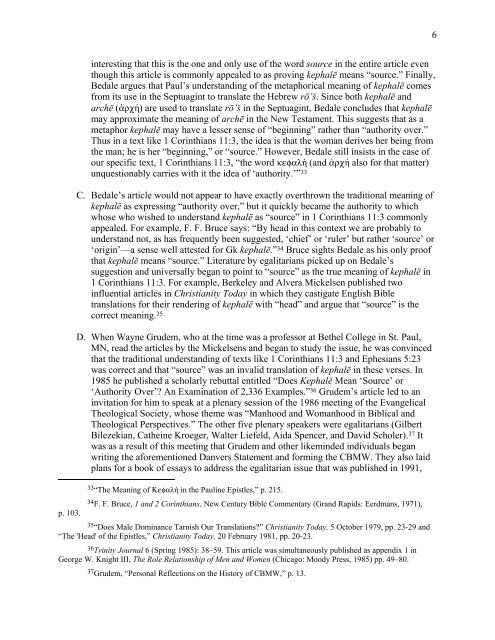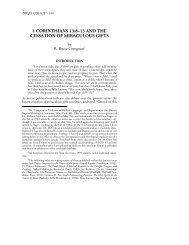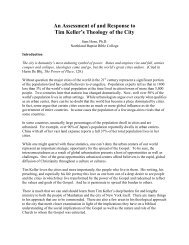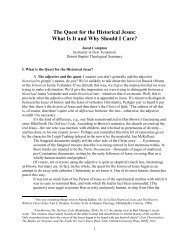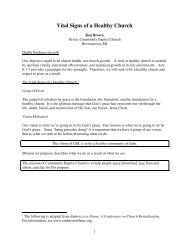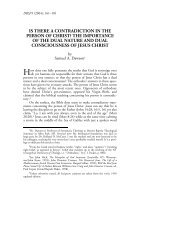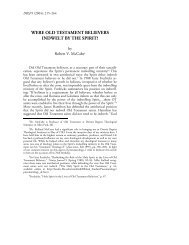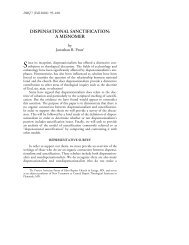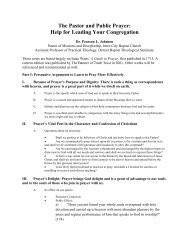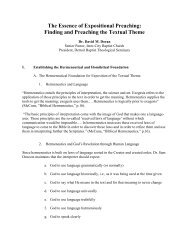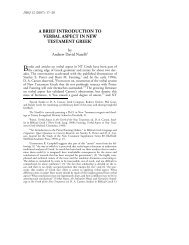Combs, Role of Women in the Church - Detroit Baptist Theological ...
Combs, Role of Women in the Church - Detroit Baptist Theological ...
Combs, Role of Women in the Church - Detroit Baptist Theological ...
You also want an ePaper? Increase the reach of your titles
YUMPU automatically turns print PDFs into web optimized ePapers that Google loves.
6p. 103.<strong>in</strong>terest<strong>in</strong>g that this is <strong>the</strong> one and only use <strong>of</strong> <strong>the</strong> word source <strong>in</strong> <strong>the</strong> entire article eventhough this article is commonly appealed to as prov<strong>in</strong>g kephalē means “source.” F<strong>in</strong>ally,Bedale argues that Paul’s understand<strong>in</strong>g <strong>of</strong> <strong>the</strong> metaphorical mean<strong>in</strong>g <strong>of</strong> kephalē comesfrom its use <strong>in</strong> <strong>the</strong> Septuag<strong>in</strong>t to translate <strong>the</strong> Hebrew rō’š. S<strong>in</strong>ce both kephalē andarchē (ἀρχή) are used to translate rō’š <strong>in</strong> <strong>the</strong> Septuag<strong>in</strong>t, Bedale concludes that kephalēmay approximate <strong>the</strong> mean<strong>in</strong>g <strong>of</strong> archē <strong>in</strong> <strong>the</strong> New Testament. This suggests that as ametaphor kephalē may have a lesser sense <strong>of</strong> “beg<strong>in</strong>n<strong>in</strong>g” ra<strong>the</strong>r than “authority over.”Thus <strong>in</strong> a text like 1 Cor<strong>in</strong>thians 11:3, <strong>the</strong> idea is that <strong>the</strong> woman derives her be<strong>in</strong>g from<strong>the</strong> man; he is her “beg<strong>in</strong>n<strong>in</strong>g,” or “source.” However, Bedale still <strong>in</strong>sists <strong>in</strong> <strong>the</strong> case <strong>of</strong>our specific text, 1 Cor<strong>in</strong>thians 11:3, “<strong>the</strong> word κεφαλή (and ἀρχή also for that matter)unquestionably carries with it <strong>the</strong> idea <strong>of</strong> ‘authority.’” 33C. Bedale’s article would not appear to have exactly overthrown <strong>the</strong> traditional mean<strong>in</strong>g <strong>of</strong>kephalē as express<strong>in</strong>g “authority over,” but it quickly became <strong>the</strong> authority to whichwhose who wished to understand kephalē as “source” <strong>in</strong> 1 Cor<strong>in</strong>thians 11:3 commonlyappealed. For example, F. F. Bruce says: “By head <strong>in</strong> this context we are probably tounderstand not, as has frequently been suggested, ‘chief’ or ‘ruler’ but ra<strong>the</strong>r ‘source’ or‘orig<strong>in</strong>’—a sense well attested for Gk kephalē.” 34 Bruce sights Bedale as his only pro<strong>of</strong>that kephalē means “source.” Literature by egalitarians picked up on Bedale’ssuggestion and universally began to po<strong>in</strong>t to “source” as <strong>the</strong> true mean<strong>in</strong>g <strong>of</strong> kephalē <strong>in</strong>1 Cor<strong>in</strong>thians 11:3. For example, Berkeley and Alvera Mickelsen published two<strong>in</strong>fluential articles <strong>in</strong> Christianity Today <strong>in</strong> which <strong>the</strong>y castigate English Bibletranslations for <strong>the</strong>ir render<strong>in</strong>g <strong>of</strong> kephalē with “head” and argue that “source” is <strong>the</strong>correct mean<strong>in</strong>g. 35D. When Wayne Grudem, who at <strong>the</strong> time was a pr<strong>of</strong>essor at Be<strong>the</strong>l College <strong>in</strong> St. Paul,MN, read <strong>the</strong> articles by <strong>the</strong> Mickelsens and began to study <strong>the</strong> issue, he was conv<strong>in</strong>cedthat <strong>the</strong> traditional understand<strong>in</strong>g <strong>of</strong> texts like 1 Cor<strong>in</strong>thians 11:3 and Ephesians 5:23was correct and that “source” was an <strong>in</strong>valid translation <strong>of</strong> kephalē <strong>in</strong> <strong>the</strong>se verses. In1985 he published a scholarly rebuttal entitled “Does Kephalē Mean ‘Source’ or‘Authority Over’? An Exam<strong>in</strong>ation <strong>of</strong> 2,336 Examples.” 36 Grudem’s article led to an<strong>in</strong>vitation for him to speak at a plenary session <strong>of</strong> <strong>the</strong> 1986 meet<strong>in</strong>g <strong>of</strong> <strong>the</strong> Evangelical<strong>Theological</strong> Society, whose <strong>the</strong>me was “Manhood and Womanhood <strong>in</strong> Biblical and<strong>Theological</strong> Perspectives.” The o<strong>the</strong>r five plenary speakers were egalitarians (GilbertBilezekian, Ca<strong>the</strong><strong>in</strong>e Kroeger, Walter Liefeld, Aida Spencer, and David Scholer). 37 Itwas as a result <strong>of</strong> this meet<strong>in</strong>g that Grudem and o<strong>the</strong>r likem<strong>in</strong>ded <strong>in</strong>dividuals beganwrit<strong>in</strong>g <strong>the</strong> aforementioned Danvers Statement and form<strong>in</strong>g <strong>the</strong> CBMW. They also laidplans for a book <strong>of</strong> essays to address <strong>the</strong> egalitarian issue that was published <strong>in</strong> 1991,33 “The Mean<strong>in</strong>g <strong>of</strong> Κεφαλή <strong>in</strong> <strong>the</strong> Paul<strong>in</strong>e Epistles,” p. 215.34 F. F. Bruce, 1 and 2 Cor<strong>in</strong>thians, New Century Bible Commentary (Grand Rapids: Eerdmans, 1971),35 “Does Male Dom<strong>in</strong>ance Tarnish Our Translations?” Christianity Today, 5 October 1979, pp. 23-29 and“The 'Head' <strong>of</strong> <strong>the</strong> Epistles,” Christianity Today, 20 February 1981, pp. 20-23.36 Tr<strong>in</strong>ity Journal 6 (Spr<strong>in</strong>g 1985): 38–59. This article was simultaneously published as appendix 1 <strong>in</strong>George W. Knight III, The <strong>Role</strong> Relationship <strong>of</strong> Men and <strong>Women</strong> (Chicago: Moody Press, 1985) pp. 49–80.37 Grudem, “Personal Reflections on <strong>the</strong> History <strong>of</strong> CBMW,” p. 13.


